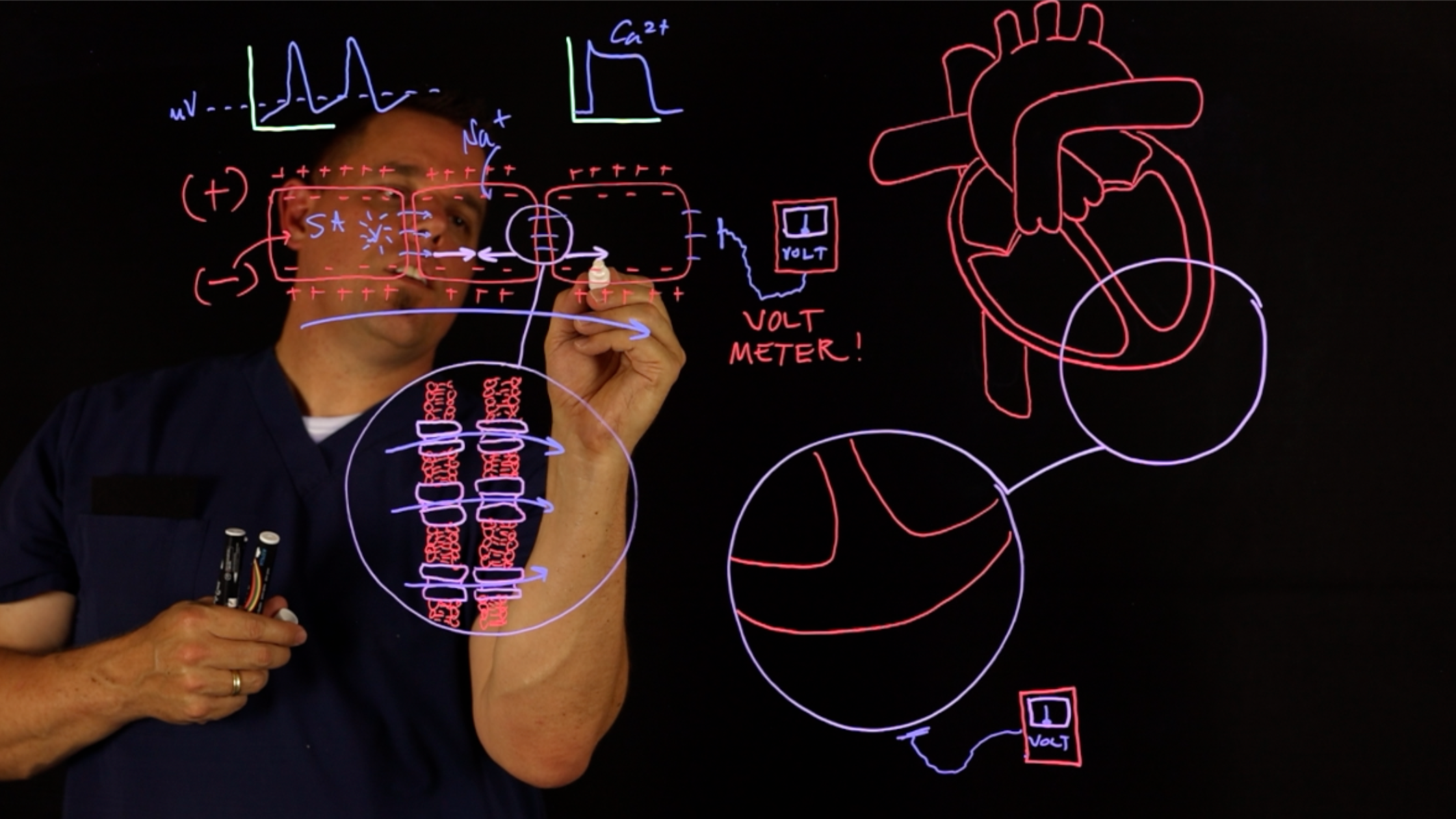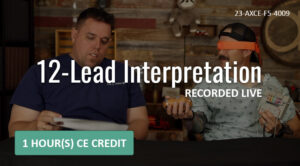How to Read an EKG in 3 Steps
Author: Erik D. Axene, MD, FACEP, MA
EKGs can feel intimidating, but they don’t have to be. One of my favorite things at ACE is to simplify complicated topics and equip first responders to better care for their patients. Helping providers of all levels gain confidence in their skills is at the heart of why we do what we do at ACE.
We tried to tell you everything you need to know about EKGs in one blog post, but it was difficult! For a FREE comprehensive course on 12-lead interpretation, click below:
3 Steps to Read an EKG
Our ACE approach to EKGs is to first look at the rate then the rhythm, and then the QRS complex. This will cover 95% of all EKGs that you will encounter. We like to ask three questions:
- Is it fast or slow? (Rate)
- Is it regular or irregular? (Rhythm)
- Is it wide or narrow? (QRS Complex)
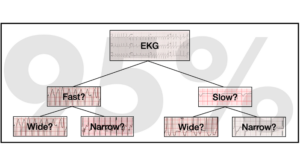
Example 1
Let’s practice! You are treating a 50-year-old male with the following EKG:

- Is it fast or slow?
- With the QRS complexes being so close together, this is a very fast rhythm with a rate greater than 200 bpm.
- Is it regular or irregular?
- Everything appears regular (consistent spacing between beats, similar pattern).
- Is it wide or narrow?
- The QRS complexes are narrow. This means that the beat originated from the top of the heart, somewhere above the ventricles. This patient is likely in SVT, as there is no evidence of p waves.
How would you treat this patient? Hopefully, you are asking for more information. We need some vitals! If the patient is appropriate for conservative management, we can first try vagal maneuvers. When done correctly, this treatment approach can be 50% effective. If not successful, adenosine can be attempted. Make sure you follow your local protocols.
ACE Tip:
Instead of using a saline flush or squeezing the IV bag to push meds into circulation, try this! Waste 1 cc of saline from a 10 cc saline flush syringe. Put 1 cc of adenosine into the syringe with the remaining 9 cc of saline. When you push this through the IV, the adenosine is injected first, followed by the remainder of the saline. This technique is very effective, administering all contents in one push! (**Make sure you follow your local EMS protocols.)
Interventional Cardiologist, Dr. Ricardo Guerra shares a helpful trick for reading a 12-lead in this video interview:
Example 2
Here’s another EKG:

- Is it fast or slow?
- With the QRS complexes being so far apart, this is a very slow rhythm with a rate of less than 30 bpm.
- Is it regular or irregular?
- Everything appears pretty regular. However, you may also notice that the p waves have their own rhythm and are not all associated with a QRS complex.
- Is it wide or narrow?
- The QRS complexes are wide. The rhythm is coming from the ventricles. This patient is likely in a third-degree block.
ACE Tip:
2 patients Atropine won’t help:
- Heart transplants patients
- Patients with 3rd degree heart blocks
Since the atrial and ventricular rates are not coordinated, what would you do to treat this patient? Again, hopefully, you are asking for more information. We need some vitals! If the patient is hypotensive (which they likely are), we will need to help the heart beat faster. Will atropine work here? Well, it will help the atria beat faster, but it won’t help the ventricular rate, which is how we generate blood pressure. So, no, atropine will not help here. What’s next? We need to pace this patient. They will ultimately need pacemaker placement. Again, make sure you follow your local protocols.
Beyond the 95% of common EKGs, we also need to be proficient at identifying specific patterns, like ST elevations, bundle branch blocks, and other less common rhythms. These dangerous patterns make up the majority of the remaining 5%. Our EKG courses at ACE cover many of these rhythms and will help you confidently identify and treatany EKG you will likely encounter!
Example 3
Here is an EKG of a 45-year-old male with chest pain. By now, you know the routine!
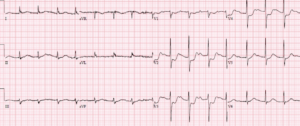
- Is it fast or slow?
- With the QRS complexes being slightly greater than three big boxes, this is relatively normal (close to 100 bpm, maybe slightly slower).
- Is it regular or irregular?
- Everything appears pretty regular.
- Is it wide or narrow?
- The QRS complexes appear narrow. The rhythm originates from above the ventricles.
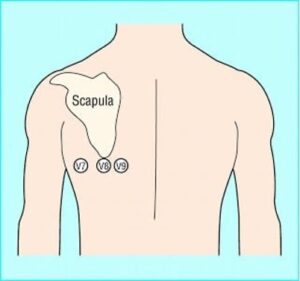
Figure 1: Lead placement for posterior EKG
What else do you see?
Look at the ST depression in V2-V4 (highlighted area below). When you see this pattern, you must perform a posterior EKG, as this is a STEMI pattern that the EKG machine cannot pick up. We will pick up the ST elevation by placing the leads for a posterior EKG (as shown to the right). You are smarter than the EKG machine, so don’t rely on it to pick up a STEMI pattern!

Here are some great resources we’d like to share with you!
Check out our Coronary Artery light board video showing where different EKG STEMI patterns affect the heart.
Enjoy our recent heart health podcast that addresses the unique health-related challenges of first responders.
Check out our EKG courses at axenece.com to learn more about this topic! We create podcast-style, entertaining lectures that make learning fun and easy. We want you to enjoy your job and feel good about the care you give to your patients!
Save $50 with an Annual Subscription
With an annual subscription, you’ll gain unlimited access to our library of CE courses. Click below to save $50!
About Axene Health Partners, LLC (AHP)
AHP is an independent actuarial and clinical healthcare consulting firm, established in 2003 and wholly owned and operated by its Partners. AHP provides healthcare consulting services to a wide spectrum of healthcare companies including health plans, health insurance companies, healthcare providers, brokers, employee benefit plan sponsors, healthcare innovators, and various governments and regulatory agencies. AHP has offices throughout the United States with its corporate headquarters located in Texas. For more information, please see www.axenehp.com.
About Axene Continuing Education, LLC (ACE)
ACE is a wholly owned subsidiary of AHP based in Texas committed to providing high-quality, practical educational experiences that support the learner in their commitment to provide the best possible healthcare to their patients. Initially, these efforts have been focused on firefighters, EMS, and EMT professionals. For more information, please see www.axenece.com.
